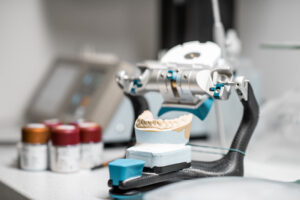Tooth decay, widely recognised as dental caries, stands as one of the most prevalent oral health challenges faced by people globally, irrespective of age. This condition, characterised by the deterioration of tooth structure, emerges from a complex interplay between the bacteria residing in our mouths and the consumption of sugary foods and beverages. The process begins with the formation of dental plaque, a sticky biofilm that clings to the teeth. When sugars from our diet interact with this plaque, it leads to the production of acids that gradually erode the tooth enamel, the hard, protective outer layer of our teeth.
The implications of tooth decay extend beyond mere discomfort or aesthetic concerns. If left unchecked, it can lead to severe dental pain, infection, and even tooth loss, significantly impacting an individual’s quality of life and overall health. Moreover, tooth decay can be a gateway to a range of other health issues, underscoring the importance of oral health in our general well-being.
In this comprehensive blog, we aim to delve deep into the various facets of tooth decay. We will explore its primary causes, identifying the factors that put individuals at risk and the mechanisms through which decay develops. Recognising the signs and symptoms of tooth decay is crucial for early intervention, and we will highlight these indicators to help you stay vigilant. Prevention, as in many health-related matters, plays a key role. We will discuss effective strategies to prevent tooth decay, focusing on both individual practices and broader lifestyle choices.
Furthermore, understanding that tooth decay is a progressive condition, we will outline the various treatment options available. From early-stage interventions to more advanced dental procedures, we will provide insights into how modern dentistry addresses this pervasive issue.
Through this blog, our goal is to equip you with the knowledge and tools necessary to combat tooth decay, ensuring that you maintain not just a healthy smile, but also contribute positively to your overall health and well-being. Whether you are looking to enhance your personal oral care routine or seeking information to support others, this guide will serve as a valuable resource in your journey towards optimal oral health.
Primary Causes of Tooth Decay
Tooth decay is a process that begins at the very surface of the tooth. The enamel, known for its hardness and resilience, is the first line of defence against decay. However, it is vulnerable to the acids produced by the bacteria in dental plaque, a sticky film that continuously forms on our teeth. This plaque is a breeding ground for bacteria, especially when it interacts with sugars and starches in our diet. The bacteria metabolise these sugars, releasing acids that gradually erode the enamel. Over time, this erosion can lead to the formation of cavities, small holes in the teeth that can grow larger and deeper if left untreated.
Several key factors contribute to the development of tooth decay:
- Poor Oral Hygiene: Regular brushing and flossing are essential in removing plaque. Neglecting these practices allows plaque to build up, providing a haven for bacteria to thrive and produce acids. This continuous acid attack weakens the enamel, leading to decay.
- Diet Rich in Sugars and Starches: Consuming foods and beverages high in sugars and starches significantly increases the risk of tooth decay. These substances are the primary fuel for the bacteria in plaque, and frequent snacking on such foods provides a constant supply of this fuel, exacerbating the problem.
- Fluoride Deficiency: Fluoride plays a critical role in preventing tooth decay. It helps in remineralising the enamel, making it more resistant to acid attacks. A lack of sufficient fluoride, whether in drinking water, toothpaste, or other sources, can leave teeth more vulnerable to decay.
- Dry Mouth: Saliva is not just important for digestion; it also plays a crucial role in oral health. It helps wash away food particles and neutralises the acids produced by bacteria. A dry mouth, which can be caused by certain medications, medical conditions, or lifestyle choices, reduces saliva production, thereby increasing the risk of tooth decay.
Understanding these primary causes is the first step in preventing tooth decay. By addressing these factors, individuals can significantly reduce their risk and maintain healthier teeth. In the following sections, we will explore the signs and symptoms of tooth decay, effective prevention strategies, and the treatment options available for those affected by this condition.
Preventing Tooth Decay
The prevention of tooth decay is a multifaceted approach that combines diligent oral hygiene practices with mindful lifestyle choices. By adopting these preventive measures, you can significantly reduce the risk of developing cavities and maintain a healthy oral environment. Here’s a closer look at these strategies:
- Brush with Fluoride Toothpaste: Brushing your teeth at least twice a day with fluoride toothpaste is fundamental in preventing tooth decay. Fluoride is a key ingredient in strengthening tooth enamel and making it more resistant to acid attacks. Ensure you brush for at least two minutes, covering all surfaces of your teeth, including the hard-to-reach back teeth and along the gum line.
- Floss Daily: Flossing daily is crucial in removing plaque and food particles from between your teeth and under the gum line, areas where your toothbrush might not reach. Regular flossing helps prevent the buildup of plaque, which can lead to tooth decay and gum disease.
- Limit Sugary and Starchy Snacks and Drinks: Sugary and starchy foods and beverages are the primary culprits in tooth decay. They provide the bacteria in your mouth with the fuel they need to produce harmful acids. Limiting your intake of these items, especially between meals, can significantly reduce your risk of developing cavities.
- Drink Fluoridated Tap Water: Drinking tap water that contains fluoride can help prevent tooth decay. Fluoride in water works in tandem with fluoride in toothpaste to strengthen teeth. If your local water supply is not fluoridated, talk to your dentist about fluoride supplements.
- Regular Dental Visits: Visiting your dentist regularly for check-ups and professional cleanings is essential in preventing tooth decay. Your dentist can spot early signs of decay and provide treatments to stop its progression. Professional cleanings are also crucial in removing tartar, a hardened form of plaque that cannot be removed by brushing and flossing alone.
- Consider Dental Sealants: Dental sealants are a protective coating applied to the chewing surfaces of the back teeth (molars and premolars). These sealants effectively shield the grooves and fissures on these surfaces from food particles and plaque, significantly reducing the risk of decay in these vulnerable areas.
- Chew Sugar-Free Gum: Chewing sugar-free gum, especially after meals, can help in preventing tooth decay. It stimulates saliva production, which neutralises plaque acids, washes away food particles, and remineralises tooth enamel.
- Maintain a Balanced Diet: A balanced diet rich in fruits, vegetables, and dairy products can contribute to stronger teeth and healthier gums. Foods high in calcium and phosphorus can help remineralise tooth enamel.
By integrating these practices into your daily routine, you can create a strong defence against tooth decay. Remember, the health of your mouth is a mirror of your overall health, and taking care of your teeth and gums is an essential part of maintaining your general well-being.
Signs and Symptoms of Tooth Decay
Early detection of tooth decay is crucial in preventing its progression and avoiding serious dental complications. Being aware of the signs and symptoms of tooth decay can help you seek timely dental care, potentially saving your teeth from extensive damage. Here are some key indicators to watch for:
- Toothache or Tooth Sensitivity: One of the first signs of tooth decay is a toothache or a noticeable increase in tooth sensitivity. This sensitivity might be a response to hot, cold, sweet, or very acidic foods and drinks. It can also manifest as a sharp pain when biting down on something hard. If you experience persistent or recurring toothaches or sensitivity, it’s a strong indicator that you should visit your dentist.
- Visible Holes or Pits in Your Teeth: As tooth decay progresses, it can lead to the formation of holes or pits in the affected tooth. These cavities are often visible to the naked eye or can be felt with the tongue. Cavities require professional dental treatment to prevent further decay and restore the tooth’s integrity.
- Brown, Black, or White Staining on Any Surface of a Tooth: Discoloration on the surface of your teeth can be an early sign of decay. These stains may appear as white spots, which indicate the loss of mineral content in the enamel (a process known as demineralization), or as brown or black spots, which suggest more advanced decay.
- Pain When You Bite Down: Experiencing pain or discomfort when biting or chewing can be a sign of decay, particularly if the pain persists or occurs every time you bite down. This symptom may indicate that the decay has reached the inner layers of the tooth, affecting the nerves and causing pain.
- Swelling of the Gums Around a Tooth: Sometimes, tooth decay can affect the surrounding gum tissue, leading to swelling or tenderness in the gums around the affected tooth. This could also be a sign of an abscess, which is a more serious condition requiring immediate dental attention.
- Bad Breath or Unpleasant Taste in the Mouth: Persistent bad breath or a bad taste in your mouth, despite good oral hygiene, can be a sign of tooth decay. As the decay progresses, it can harbour bacteria that produce these unpleasant symptoms.
Recognising these signs and symptoms is the first step in combating tooth decay. If you notice any of these indicators, it’s important to schedule an appointment with your dentist as soon as possible. Early intervention can mean the difference between a simple filling and more extensive dental procedures. Remember, regular dental check-ups are also key in detecting tooth decay before symptoms even appear.
Treatment of Tooth Decay
The approach to treating tooth decay varies depending on the stage and severity of the condition. At the earliest signs of decay, intervention can be minimal, but as the decay progresses, more extensive treatments may be required to restore the health and function of the affected teeth. Here’s a breakdown of the common treatments for tooth decay:
- Fluoride Treatments: In the very early stages of decay, when a cavity hasn’t fully formed, fluoride treatments can help reverse the process. Fluoride, a natural mineral, can help to remineralise and strengthen the enamel. These treatments may involve fluoride varnish, gel, or liquid, which is applied directly to the teeth. They are particularly effective in the initial stages of surface decay and can prevent further damage.
- Fillings: Once a cavity has formed, the decayed portion of the tooth needs to be removed and filled. Fillings can be made from various materials, including amalgam (silver fillings), composite resins (tooth-coloured fillings), or gold. The choice of material depends on the location of the cavity, the extent of the decay, and aesthetic considerations.
- Crowns: For more extensive decay or in cases where the tooth structure has been significantly weakened, a crown may be necessary. A crown is a custom-fitted covering that replaces the entire natural crown of the tooth. It’s made from various materials like porcelain, ceramics, or metal alloys and is designed to strengthen and restore the tooth’s shape and function.
- Root Canals: If the decay progresses to the point where it affects the tooth’s pulp (the innermost part containing nerves and blood vessels), a root canal treatment may be required. This procedure involves removing the infected or damaged pulp, cleaning and disinfecting the inner chambers of the tooth, and then filling and sealing them. A crown is often placed over the tooth after a root canal to provide additional protection and strength.
- Tooth Extractions: In severe cases, where the decay is extensive and the tooth is beyond repair, extraction may be the only option. Removing the decayed tooth can prevent the spread of decay and infection to other teeth and the surrounding tissues. After an extraction, there are several options for replacing the missing tooth, such as dental implants, bridges, or dentures, to restore function and aesthetics.
The choice of treatment depends on various factors, including the extent of decay, the patient’s overall oral health, and personal preferences. Regular dental check-ups are crucial in detecting and treating tooth decay early, preventing the need for more invasive procedures. At each stage of decay, there are effective treatment options available to restore dental health and maintain a healthy, functional smile.
Tooth decay, while a common dental issue, is largely preventable and manageable with the right approach and care. Understanding the causes and being vigilant about the symptoms are key steps in safeguarding your oral health against this pervasive condition. The implementation of good oral hygiene practices, such as regular brushing and flossing, using fluoride toothpaste, and maintaining a balanced diet low in sugary and starchy foods, forms the foundation of preventing tooth decay. Additionally, incorporating regular dental check-ups into your healthcare routine is crucial for early detection and treatment of any dental issues, including decay.
It’s important to remember that oral health is a vital component of your overall well-being. Healthy teeth and gums contribute not only to a functional and aesthetic smile but also play a significant role in your general health. Issues like tooth decay, if left untreated, can lead to more serious health problems, making early intervention and consistent care essential.
If you ever notice signs of tooth decay, such as toothache, sensitivity, visible holes or pits in your teeth, or any other unusual changes in your oral health, it’s imperative to consult your dentist without delay. Timely and appropriate dental treatment can not only resolve the immediate issue but also prevent future complications.
By staying informed, being proactive about your oral hygiene, and maintaining regular dental visits, you can effectively manage your risk of tooth decay and enjoy a healthy, confident smile. Remember, taking care of your teeth today is an investment in your health for tomorrow.




